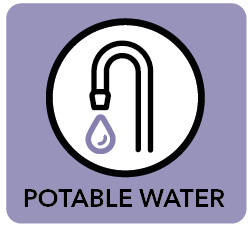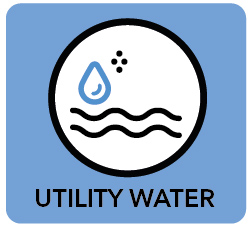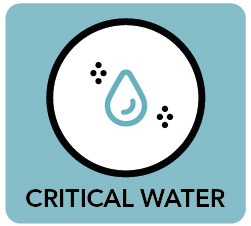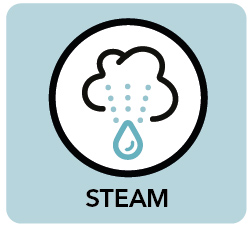The Importance of Water Quality in Medical Device Processing
Understanding ANSI/AAMI ST108
Water is used to clean, disinfect, and sterilize millions of medical devices daily. Tap water isn't sufficient for all device processing steps. Quality water for processing instruments improves cleaning chemistry effectiveness, reduces corrosion/damage, and improves steam quality for sterilization.
Effect of Poor Water Quality in Sterile Processing

Water Staining on Washer/Disinfector Chamber
Water used in sinks and washer/disinfectors in sterile processing starts as moist air in our atmosphere. It falls through the air as rain and passes through soil, ponds, rivers, and lakes while gathering impurities. The types of impurities in the water your local municipality delivers to your facility can vary by the geographic area, types of soil, and the pipes it travels through.
In sterile processing, poor water quality can damage equipment used to process devices, making washer/disinfectors and steam sterilizers work harder and use more energy. Impurities can also reduce the effectiveness of cleaning chemistries, requiring several passes through the sink or washer before all soils are removed.
Instruments can also be damaged from poor water quality, leading to:

Staining & Pitting of Surgical Instruments
- Staining
- Corrosion
- Pitting
- Reduced mobility of moving parts
- Blocked lumens
- Discoloration
- Malfunction
Instrument and equipment damage increases repair and replacement costs to the facility and can also increase the risk of adverse effects to patients. Reactions to water impurities left behind after processing can cause fevers, inflammations, and other complications. Impurities can shield microorganisms and interfere with disinfection and sterilization processes, potentially contributing to hospital-acquired infections.
What is ANSI/AAMI ST108?

ANSI/AAMI ST108 defines the water quality needed for each step of medical device processing to support positive patient outcomes. The standard discusses the categories of water, water quality requirements, and the maintenance of water processing systems. Initially published in 2023, the standard's primary goal was reducing the negative effects of water impurities, bacteria, and endotoxin deposits on medical devices.
Who must follow ANSI/AAMI ST108?
ANSI/AAMI ST108 is designed for healthcare facilities in the United States, including hospitals, clinics, ambulatory surgery centers, endoscopy centers, and offsite reprocessing facilities.
According to The Joint Commission (TJC), compliance with AAMI standards is mandatory only when specified by statute (as in the State of New Jersey) or when the standard is cited explicitly by a facility's written policy and procedures. Regulators understand it takes considerable time for Sterile Processing Departments (SPD) to adjust or replace equipment to conform to the recommendations in ANSI/AAMI ST108.
What does ANSI/AAMI ST108 Cover?
The standard covers five subject areas critical for ensuring the quality of water used for reprocessing surgical instruments and other devices.
- Roles and Responsibilities
- Water Quality and Use
- Water Treatment Systems
- Quality Control
- Other Special Considerations
Roles and Responsibilities of Water Quality Management
The first section discusses hospital personnel's roles and responsibilities in managing water quality for medical device processing. This includes the role of a multidisciplinary team to develop, implement, and monitor a water management program, which might require conducting a risk analysis to mitigate poor water quality.
Types of Water Quality
The standards describe four categories of water, which are based on the water's properties and the measurement of specific impurities. The properties of water that help define the categories of water include pH, total alkalinity, color and turbidity, and conductivity.
With each progressing water category, the number of impurities decreases. These are just a few examples of the different requirements between tap water, utility water, critical water, and steam. Regarding ST108 specifically, the standard recommends controlling 13 different types of impurities known to cause adverse effects on devices, equipment, and/or patients.
Tap water typically needs some treatment before being used as utility water in device processing, but specialized chemistries like Prolystica Instrument Cleaning Chemistries are formulated to help manage water impurities. This means further "tap water" treatment may not be necessary.
Water Quality for Manual Cleaning of Medical Devices

Device processing begins in the procedure room or surgical suite with point-of-use treatment. ANSI/AAMI ST108 indicates utility water may be used post-procedure to prepare point-of-use treatment solutions and maintain a moist instrument. It is important to note facility policies dictate the use of point-of-use products or sterile water during the point-of-use treatment. Products like PRE-KLENZ Point of Use Processing Gel can be used instead of water or soaking, depending on facility policies and procedures.
Once devices move to decontamination, utility water is used at the sink for the cold-water rinse of devices treated with a pretreatment product. Utility water is also mixed with instrument cleaning chemistries, such as Prolystica HP Instrument Cleaning Chemistries, and this cleaning solution is used for the intermediate rinses. The final rinse at the cleaning sink should use critical water.
Water Quality for Medical Washer/Disinfectors

There are two types of medical washers in healthcare. The first only cleans and rinses the medical devices without disinfecting them. The second, such as the AMSCO 7053HP Washer/Disinfector, cleans, rinses, and disinfects the devices using thermal disinfection. The water category needed depends on the stage or phase of the washer cycle.

Utility water is used for:
- Initial rinse to remove blood and other soils from instruments.
- Wash stage, with added instrument cleaning chemistries.
- Post-wash rinse stage to remove residual chemistry.
- Chemical disinfection stage, where disinfectant concentrate is added.
Critical water is used for:
- Final rinse and for all rinses after the chemical disinfection stage.
- Thermal disinfection stage, where heated critical water is used.
Water Quality for Medical Ultrasonic Washers
Ultrasonic washers are mechanical cleaners that use cavitation to remove soil from device surfaces. Like the washer/disinfectors, utility water is used to rinse the devices before placement in the cleaner and make the cleaning solution. Generally, unless specified by the device manufacturer, utility water is used for all steps in the cycle. The final rinse, however, should use critical water.
Some medical devices, such as particular ophthalmic instrumentation, may require a different water quality. Read all instructions for use (IFUs) before selecting water for this application.
Water Quality for High-Level Disinfection of Medical Devices

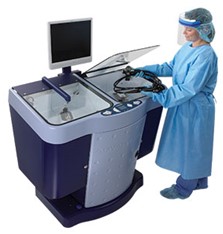
Manual high-level disinfection occurs after the device has been cleaned and rinsed using utility water. Utility water may be used (consult HLD manufacturer’s IFUs) to dilute high-level disinfectant concentrate, and following disinfection, devices are rinsed using only critical water.
Automated high-level disinfection is conducted in an "Automated Endoscope Reprocessor (AER)," and utility water is used for cleaning solutions, post-wash rinses, and as a base for high-level disinfectant solutions made from concentrates. Mechanical high-level disinfection systems often incorporate water treatments at the point of use that ensure proper water treatment for the final rinse. ST108 does not specify the requirements for water quality in an AER. Always read the IFUs to ensure the proper water quality is plumbed to the equipment.
Water Quality for Steam Sterilization of Medical Devices
The standard provides recommendations for steam condensate, but steam quality and steam generation are explicitly covered in ANSI/AAMI ST79. ST108 states that steam condensate should be tested at the point of use, and there is a requirement for monthly and quarterly testing.
Water Treatment & Testing for Medical Facilities

Obtaining and maintaining the water quality necessary for medical device reprocessing requires a water treatment system. Water treatment equipment is designed to remove one or more water impurities using either physical filters or chemical treatments, and the mechanisms used depend on the impurity's size and chemical properties. Because every facility will be different, consulting with a water treatment company is often necessary.
Quality testing, performance testing, routine testing, and continuous improvement through trend analysis will ensure the continued success of any facility's water treatment plan.
ANSI/AAMI ST108 - Water for the processing of medical devices
"ANSI/AAMI ST108 Water for the processing of medical devices" is a valuable tool in preventing adverse effects from poor water quality in device processing. The best use of this tool comes after you have identified the potential risks in your facility's water. Each facility should create a multidisciplinary team and perform a baseline risk assessment, including water testing.
A copy of the standard can be purchased from AAMI and provides guidance to develop and support a water quality program to help keep the SPDs running smoothly.
Learn more about Water Quality & ST108 from STERIS University, and earn Free CE Credit
NOTE: This summary is not intended to be a substitute for purchasing, reading, and understanding ANSI/AAMI ST108:2023 in its entirety. It is solely the healthcare facility's responsibility to interpret the standard and determine appropriate policies and procedures.
 United States
United States
 Canada (EN)
Canada (EN) Canada (FR)
Canada (FR) Deutschland
Deutschland Italia
Italia United Kingdom
United Kingdom Australia
Australia New Zealand
New Zealand Singapore
Singapore Brasil
Brasil México
México



